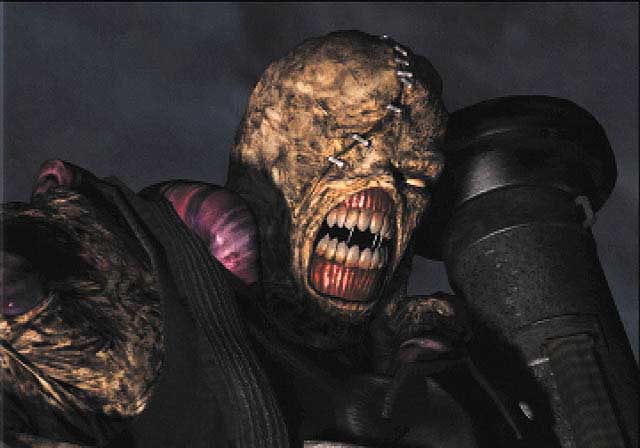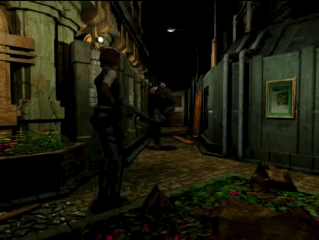Resident Evil 3: Killing Nemesis (Level Design and Movement)
November 3rd, 2017
Having extensively researched Resident Evil: Code Veronica‘s level design last year, I set myself an extra challenge when recently completing Resident Evil 3. I decided to defeat Nemesis (the Terminator-esque monster who ruthlessly pursues the player) in all 11 encounters with him throughout the game. Although my playthrough was greatly lengthened by the pursuit, the experience helped me better understand classic Resident Evil movement and combat and why they’re perhaps not so fondly remembered.
Level Design
Resident Evil 3‘s interlinked city environments belong to the Resident Evil 2 style of level design. The player traverses each main area about two or three times before moving onto the next. Usually one of the backtracking paths will feature new enemies or situations to surprise players. By contrast, Resident Evil 1 takes place entirely within the a single interconnected environment and can therefore craft more folded and organic level design. Code Veronica draws from both styles and as such I think it probably would have been a better title to close the trilogy, at least in terms of level design variety.
Jill’s path through Racoon City runs through a series of laneways and buildings which wind around numerous roadblocks resulting from the city’s decay. Yet while authentic to the game’s overall theme of aftermath and destruction, the mishmash of loosely associated environments don’t lend themselves well to memorisation. In particular, the linked rings layout of Downtown don’t break down into manageable shapes.
Movement
The player can make Jill run by tilting the analogue stick forward. By then tilting the stick to one of the adjacent diagonal positions, Jill will turn whilst running. However, if the player tilts too far in one direction and the input registers as a tilt to the left or right, Jill will stop running and rotate on the spot. The analogue nature of the dual shock stick makes it difficult to identify the sweet spot between the diagonal and horizontal input selections. So I found that I would sometimes inadvertently stop Jill dead in her tracks, thus leaving her vulnerable to attacks. This problem usually occurred in the Nemesis battles, which require Jill to tightly circle the monster.
Resident Evil 3 features a quick dodge mechanic where the player can avoid attacks by aiming and firing their weapon as an enemy attacks. The unintuitive button configuration speaks for itself in that sometimes the player will attempt to attack, but will instead dodge, and vice versa. In this way, the game’s output betrays your own input. The timing needed to execute the quick dodge is also extremely tight (on hard mode). And even though I defeated Nemesis on every occasion, I could never intentionally perform a dodge. Sometimes the dodge animation will put Jill in a position where she will take damage or cannot avoid the subsequent attack. For all of the reasons, I found the mechanic to be rather unreliable.
The quick turn (another new mechanic) also has its own quirks. In order to have Jill turn 180 degrees and run in the opposite direction (which is usually what you want her to do after turning), the player must press square and tilt down on the analogue stick before then tilting up to initiate the run. For quickly fleeing from enemies, the input process is simply too complicated.
The transitions when moving between prerendered backdrops require the player constantly recalibrate their orientation, which in the midst of a fight can understandably lead to error.
Beating Nemesis
Doing a “kill Nemesis” run fundamentally changes the nature of the game. Nemesis takes a load of firepower to down, so players must set aside a major portion of their munitions for the task. Given your regular neighbourhood zombie also seeks to drain you of resources, saving ammo translates to avoiding zombies, which requires a good understanding of their placement, direction, avoidance strategies, and reset options (leaving and re-entering a room). So by focusing on Nemesis, you stress a different area of the game system.
In terms of confronting the monster itself, the trick is to run around him, turn, shoot, and repeat. You must always brush past his shorter left-arm, as his right-arm has much greater reach. You must also stay within a set distance away from him, otherwise you’ll prompt him to burst out into a sprint attack, which is much harder to avoid. If you can master this simple technique, then Nemesis isn’t all that difficult…
…at least not in open environments. The first confrontation out the front of the police station provides a good amount of room to develop your technique. However, several of the subsequent scenarios take place in corridors, where you have much less wiggle room to navigate and effectively have to run into Nemesis to avoid him. Overall, I found that these confrontations tend to highlight the weaknesses in the movement mechanics, as mentioned earlier.






 Game Design Companion: A Critical Analysis of Wario Land 4 - $7.99
Game Design Companion: A Critical Analysis of Wario Land 4 - $7.99 Level Design: Processes and Experiences
Level Design: Processes and Experiences Speed Boost: The Hidden Secrets Behind Arcade Racing Design - $5.99
Speed Boost: The Hidden Secrets Behind Arcade Racing Design - $5.99 Adventures in Games Analysis: Volume I - $5.99
Adventures in Games Analysis: Volume I - $5.99







